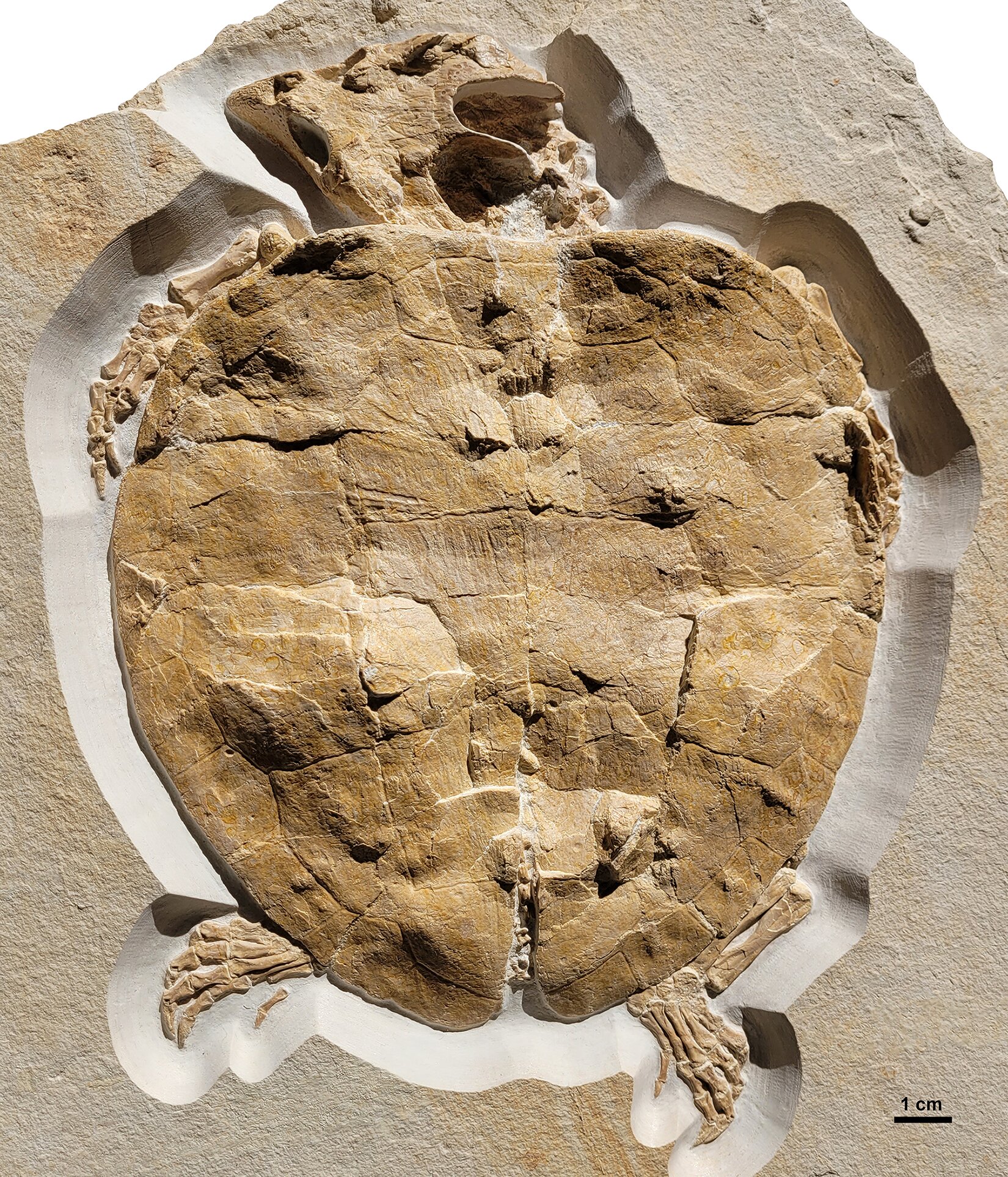This perfectly preserved turtle fossil is 150 million years old
This “pancaked” turtle dates back to the Mesozoic, around 150 million years ago.
This perfectly preserved turtle fossil discovered in Lower Bavaria is 150 million years old, and it sheds light on both the species and its habitat that thrived in southern Germany during the Mesozoic. The fossil is the most intact specimen of Solnhofia parsonsi discovered to date, suggesting coastal habitation due to its comparatively short limbs, which sharply contrasts the elongated flippers of today’s open-sea turtles.
 “We have never before seen a Solnhofia specimen with such perfectly preserved limbs,” observes Felix Augustin from the University of Tübingen’s Biogeology working group. The Solnhofia parsonsi’s head and shell are also distinctly preserved. The beak is elongated and pointed, the head is triangular, and with a length slightly over nine centimeters, it nearly accounts for half the carapace’s size.
“We have never before seen a Solnhofia specimen with such perfectly preserved limbs,” observes Felix Augustin from the University of Tübingen’s Biogeology working group. The Solnhofia parsonsi’s head and shell are also distinctly preserved. The beak is elongated and pointed, the head is triangular, and with a length slightly over nine centimeters, it nearly accounts for half the carapace’s size.
Solnhofia Parsonsi: A Perfectly Preserved Turtle fossil
“Solnhofia’s large head could have been used for crushing hard food items like shelled invertebrates, similar to some modern turtles. However, this doesn’t necessarily imply that such items were the only components of its diet,” points out Márton Rabi, a University of Tübingen scholar and co-author of the study, published in the PLOS ONE journal.
The moniker Solnhofia draws its origin from the limestone deposits of Solnhofen, situated south of Nuremberg in the Altmühl valley, famous for its rich cache of fossils, including those of Archaeopteryx—one of the earliest birds—and numerous pterosaurs and marine reptiles.
The Solnhofia parsonsi fossil was unearthed in a quarry in the Painten district, west of Regensburg. The systematic excavation for fossils in this area began merely two decades ago. Andreas Matzke, another co-author of the study from the University of Tübingen, explains the extraordinary preservation of fossils in the limestone strata. “The environmental conditions of the time are key to this high level of preservation,” Matzke notes.
Around 150 million years ago, a shallow tropical sea spanned across southern Germany, punctuated by islands and reefs that separated lagoons from the open sea. When flora and fauna died, their remains sank to the basin floor, where due to the low oxygen and high salt levels, decomposition was inhibited. This allowed these remnants to fossilize within the limestone, often with remarkable detail.
The Importance of the Site
The region, which boasts an abundance of Mesozoic-era fossils, is recognized as one of the most critical fossil sites worldwide. The impressively preserved Solnhofia parsonsi fossil accentuates the significance of the relatively newly discovered site in the Painten district. The vertebrate fossils unearthed from the limestone here are currently under scientific scrutiny. The Dinosaur Museum in the nearby town of Denkendorf displays these discoveries, including the Solnhofia parsonsi.
Related Post
A shocking documentary proves that mermaids do exist
SHOCKING Revelation: Thuya, Mother of Queen Tiye, Was the Grandmother of Akhenaten and Tutankhamun—What Ancient Egyptian Secrets Did She Leave Behind?
Breaking News: Astonishing Discoveries at Karahan Tepe Confirm an Extraterrestrial Civilization is Hiding on Earth, and NO ONE Knows!
Breaking News: Researchers FINALLY Discover U.S. Navy Flight 19 After 75 Years Lost in the Bermuda Triangle!
NASA’s Secret Investigation: Uncovering the Astonishing Mystery of the UFO Crash on the Mountain!
Explosive UFO Docs LEAKED: Startling Proof That Aliens Ruled Ancient Egypt!